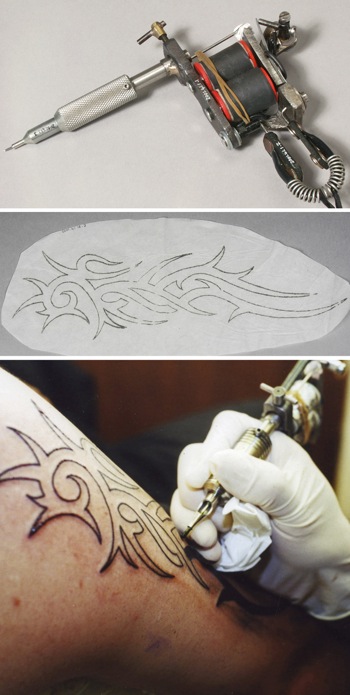Electric tattooing machine, transfer and process
Oxford England, c. 2001
 Donated by Bob ‘Eagle’ Smith in 2001; 2001.41.1–.16Tattoos in the Western world were once the mark of the outcast, the rebel, the rocker or sailor. Today, tattoos are generally less taboo and are worn, albeit in varying degrees of size and exposure, by members of all social classes and of all professions. It is not uncommon to find tattooing parlours on any British high street and the accessory common to nearly all modern practitioners of the art is the electric tattooing machine.
Donated by Bob ‘Eagle’ Smith in 2001; 2001.41.1–.16Tattoos in the Western world were once the mark of the outcast, the rebel, the rocker or sailor. Today, tattoos are generally less taboo and are worn, albeit in varying degrees of size and exposure, by members of all social classes and of all professions. It is not uncommon to find tattooing parlours on any British high street and the accessory common to nearly all modern practitioners of the art is the electric tattooing machine.
The American Samuel Reilly first patented the electric tattooing machine in 1891, using Thomas Edison's electric engraving device as inspiration. The drive principle, based on an electromagnetic coil and a spring, has remained largely unchanged since then. Amateur tattooists make use of any rotational motor (such those found in tape cassette machines, electric toothbrushes or electric razors) and affix a shaft to transform the circular movement into a vertical one. The handle or grip in the professional tattooing machine is made of surgical steel and this surrounds a channel through which one or many needles move in and out of the skin at a rate of around 150 times per second.
The donor of this tattooing machine, pattern and photograph was Bob Eagle Smith, a well-known tattoo artist in Oxford in recent years. Smith made both the needles and the main body of the machine (which is typical of the older type in having two electromagnetic coils) himself, giving him greater ability to customise his equipment to his needs. For example, he could vary the size of the grip depending on how much weight he needed to apply to the skin and he could solder different numbers of pointed or flat-headed needles to the needle-bar to suit the type of tattoo being drawn and the required results. This particular design, seen here as a template on tracing paper and then being applied to a client, was inspired by the tattoo designs used by Iban and Kayan people in Sarawak.
Early tattoo pigments were largely obtained from nature and were therefore rather limited in their colour range. The modern tattooist has a rainbow of coloured carbon-based specialist inks to choose from. Tattoos were once considered utterly permanent, removable only partially with drastic measures such as dermabrasion or skin grafting. Modern laser technology has made removal easier but even so, the process is usually more expensive and painful than applying the tattoo in the first place, and black and dark colours are easier to remove than brighter colours.
That tattooing is an intense experience for the person being tattooed is not unexpected. However, it can also be a very personal and sensory experience for the tattooist too:
"I need steady hands. I concentrate. Clip cords connect my machine to the power pack, foot peddle connects the charge. I thread my needle. A grating buzz fills the studio...I coat the temporary carbon-blue outline in a thin layer of grease and dip the tip of my needle into a tiny pot of deep maroon ink...The mechanical wasp sounds fills the room again, sustained now as I engrave the first line into her skin. I can feel the muscles in her back jolt and contract ever so slightly as my needle makes first contact. Second sweep of the line, dip into the ink, third, fourth – she lets out a slow breath and begins to relax as the initial shock passes and the sensation becomes familiar."
Gemma Angel, tattooist, visual artist and tattoo scholar on tattooing a volunteer / client in 2004
